Strong Salmon Run and Restoration Funding Flow into the Eel River, Amidst Third Consecutive State Commercial Fishery Closure
On April 15, 2025, officials announced a third consecutive closure of California’s commercial salmon fishing season. While salmon continue to struggle across the state, in North Coast watersheds, California Trout and our partners are reporting increasing returns of salmon and steelhead, and recent funding for restoration efforts in the region promises a brighter future ahead for these iconic native fish.
CalTrout and our partners operate sonar stations on the South Fork, Middle Fork, Van Duzen, and mainstem Eel River, which document fish as they pass through and provide adult salmon counts for most of the Eel River watershed. The closure of the state’s commercial salmon fishery is based on fish counts in the ocean, but it is difficult to know if these fish are from hatchery stocks from the Sacramento River, or from wild threatened stocks like the Eel River. These sonar stations provide crucial information on the health of the ocean fishery and how it interconnects with freshwater systems. The data from these sonar stations shows that this year’s Eel River fish returns have risen to 18,000 or more adult Chinook salmon, nearly doubled from the 2018 and 2019 spawning season numbers.
Although this is a far cry from historic abundance and the number needed to sustain an Eel River salmon run in the long term, the numbers have increased from previous years. In some other parts of the North Coast, salmon are returning in strong numbers too: Mendocino coast watersheds saw fantastic coho salmon returns and Marin County reported the strongest coho salmon run in 20 years. Both areas have been the focus of significant restoration efforts.


“This year’s Chinook salmon run in the Eel River is the best we’ve seen since our monitoring began in 2018, and it is especially hopeful after several years of severe drought,” said Darren Mierau, CalTrout North Coast Regional Director. “We’re still far from the numbers that the Eel River is capable of producing, but we’re feeling very optimistic about the future as we continue to strategically focus monitoring and restoration efforts in places where the fish most need our help to achieve population recovery. We are immensely grateful to our state agency partners for investing in key projects and trusting us to get this work done.”
In March 2025, the California Department of Fish and Wildlife (CDFW) authorized $2.8M to CalTrout to support Phase 2 of the Eel River Watershed Restoration & Conservation Program following a $750,000 investment in Phase 1 of the program. This funding comes from cannabis revenue and is meant to benefit watersheds that are heavily impacted by the cannabis industry, like the Eel River.
Phase 2 of the Eel River Watershed Restoration & Conservation Program will employ science-based tools to strategically prioritize where restoration and conservation investments in the Eel River will have the most benefit to salmon and steelhead population recovery and the long-term ecological resilience of this important watershed.
CDFW funding also supports CalTrout and partners in suppressing invasive pikeminnow, which prey on juvenile salmon and steelhead during outmigration. Acoustic telemetry studies show survival rates for juvenile salmon and steelhead from Eel River headwaters to the ocean are alarmingly low—less than 12% of tagged fish reach the estuary, largely due to predation by invasive pikeminnow. To improve survival, CalTrout, CDFW, UC Berkeley scientists, and the Wiyot Tribe are reducing the presence of predator-sized pikeminnow in critical river areas. Data suggests two years of suppression efforts are working, with a 47% decrease in adult-sized pikeminnow in South Fork Eel River study areas.
Recovery of the Eel River requires a comprehensive approach tackling threats to native fish across all stages of their lifecycle, identifying opportunities for restoration throughout the entire watershed, and engaging communities throughout every point in the process. Removal of the Eel River dams, continued pikeminnow suppression in the mainstem rivers, and significant investment in restoring the Eel River estuary are the most significant actions that will lead to a return of salmon and steelhead abundance in the Eel River.




About the Eel River Watershed Restoration & Conservation Program
The Eel River Watershed Restoration and Conservation Program aims to take a holistic approach to restoring and conserving the Eel River watershed with a particular focus on the river corridor. To achieve this, the Program has selected a series of focal species (Chinook and coho salmon, steelhead, Pacific lamprey, and green sturgeon) as the cornerstone for restoration and conservation planning. In addition to restoration and conservation directed towards the aquatic habitat and the species that reside in those habitats, the Program also recognizes the continuous and ongoing threat of climate change to the Eel River watershed and understands that it is necessary to implement climate mitigation strategies and strategic climate planning to support a resilient watershed. Finally, the Program is invested in the community members across the watershed. The Program strives to identify and protect the ecosystems services that support community members such as recreational access, access to clean water, and a robust and harvestable fishery. Learn more about the Eel River Watershed Restoration & Conservation program here.






